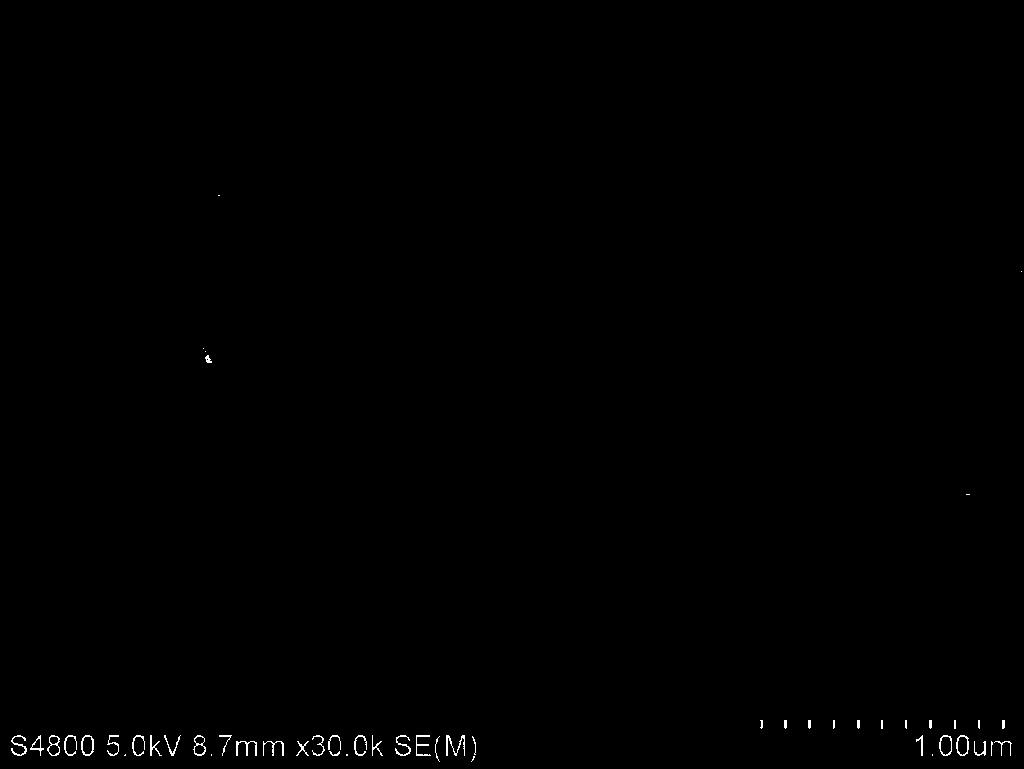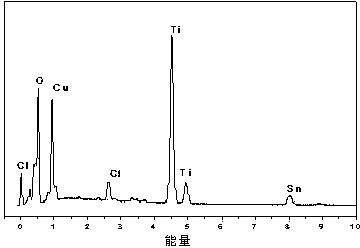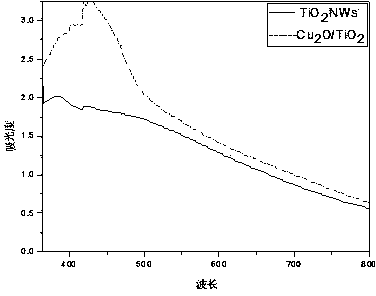Preparation method of p-n type Cu2O/TiO2 nanowire array composite film
A technology of nanowire array and composite thin film, which is applied in the direction of nanotechnology, nanotechnology, semiconductor/solid-state device manufacturing, etc., can solve the problem of low utilization rate of visible light, achieve high regularity and order, good photoelectric performance, and expand Effect of Response Range
- Summary
- Abstract
- Description
- Claims
- Application Information
AI Technical Summary
Problems solved by technology
Method used
Image
Examples
Embodiment 1
[0024] TiO 2 Fabrication of Nanowire Array Thin Films
[0025] Take 15mL of ultrapure water and 15mL of concentrated HCL with a mass fraction of 38% in a beaker and stir on a magnetic stirrer until they are evenly mixed, then add 0.5mL of tetra-n-butyl titanate dropwise to the above solution, and stir for 30 minutes to form Colorless solution (labeled solution A); put a piece of FTO substrate with the conductive side up in a 50 mL autoclave liner, then transfer the resulting colorless mixed solution A to the autoclave liner and submerge FTO substrate, and finally put the autoclave into an oven at 150°C for 12 hours; after the reaction, cool to room temperature and rinse with deionized water to obtain TiO 2 Nanowire Array Films.
[0026] p-n type Cu 2 O / TiO 2 Preparation of Nanowire Array Composite Thin Film
[0027] Prepare 0.4mol / LCuSO 4 and 3mol / LC 3 h 6 o 3 (Lactic acid) mixed solution, and adjusted to pH = 7 with 5mol / L NaOH solution to obtain a dark blue solution...
Embodiment 2
[0029] TiO 2 Fabrication of Nanowire Array Thin Films
[0030] Take 15mL of ultrapure water and 15mL of concentrated HCL with a mass fraction of 38% in a beaker and stir on a magnetic stirrer until they are evenly mixed, then add 0.5mL of tetra-n-butyl titanate dropwise to the above solution, and stir for 30 minutes to form Colorless solution (labeled solution A); put a piece of FTO substrate with the conductive side up in a 50 mL autoclave liner, then transfer the resulting colorless mixed solution A to the autoclave liner and submerge FTO substrate, and finally put the autoclave into an oven at 150°C for 12 hours; after the reaction, cool to room temperature and rinse with deionized water to obtain TiO 2 Nanowire Array Films.
[0031] p-n type Cu2 O / TiO 2 Preparation of Nanowire Array Composite Thin Film
[0032] Prepare 0.4mol / LCuSO 4 and 3mol / LC 3 h 6 o 3 (Lactic acid) mixed solution, and adjusted to pH = 8 with 5mol / L NaOH solution to obtain a dark blue solution (...
Embodiment 3
[0034] Fabrication of Nanowire Array Thin Films
[0035] Take 15mL of ultrapure water and 15mL of concentrated HCL with a mass fraction of 38% in a beaker and stir on a magnetic stirrer until they are evenly mixed, then add 0.5mL of tetra-n-butyl titanate dropwise to the above solution, and stir for 30 minutes to form Colorless solution (labeled solution A); put a piece of FTO substrate with the conductive side up in a 50 mL autoclave liner, then transfer the resulting colorless mixed solution A to the autoclave liner and submerge FTO substrate, and finally put the autoclave into an oven at 150°C for 12 hours; after the reaction, cool to room temperature and rinse with deionized water to obtain TiO 2 Nanowire Array Films.
[0036] p-n type Cu 2 O / TiO 2 Preparation of Nanowire Array Composite Thin Film
[0037] Prepare 0.4mol / LCuSO 4 and 3mol / LC 3 h 6 o 3 (Lactic acid) mixed solution, and adjusted to pH = 9 with 5mol / L NaOH solution to obtain a dark blue solution (m...
PUM
 Login to View More
Login to View More Abstract
Description
Claims
Application Information
 Login to View More
Login to View More - R&D
- Intellectual Property
- Life Sciences
- Materials
- Tech Scout
- Unparalleled Data Quality
- Higher Quality Content
- 60% Fewer Hallucinations
Browse by: Latest US Patents, China's latest patents, Technical Efficacy Thesaurus, Application Domain, Technology Topic, Popular Technical Reports.
© 2025 PatSnap. All rights reserved.Legal|Privacy policy|Modern Slavery Act Transparency Statement|Sitemap|About US| Contact US: help@patsnap.com



